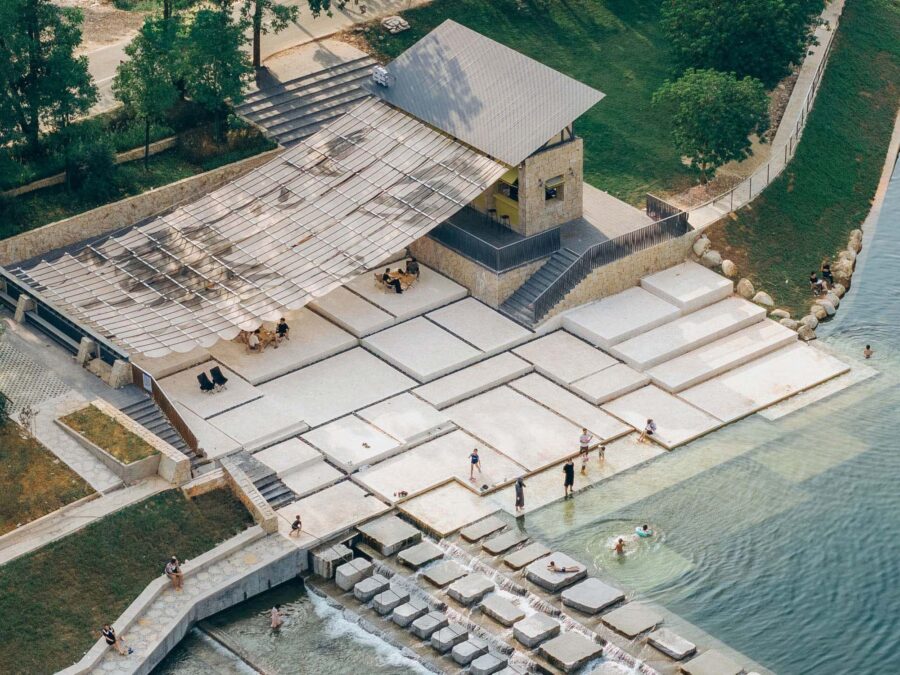
CULTURE


©︎University of Bath
バース大学、ケンブリッジ大学、ダンディー大学の構造エンジニア、数学者、製造専門家といった多分野にまたがる研究チーム「ACORN」が、薄型シェルフロア〈Thin shell〉のモックアップを公開しました。
コンクリート使用量、炭素排出量を大幅に削減し、建設業界のネットゼロ目標に貢献します。
(以下、バース大学から提供されたプレスキットのテキストの抄訳)

©︎University of Bath
建築業界をサステナブルにする床スラブシステム
同じ荷重を支える従来のコンクリート床スラブに比べ、〈Thin shell〉はコンクリート使用量を75%、建設における炭素使用量を60%削減します。

©︎University of Bath
コンクリートの特性を引き出すシェル構造
従来のコンクリートスラブには荷重を支えるために曲げ応力がかかります。ですがコンクリートは曲げに弱く、多くの鉄筋が必要となり効率が悪いといえます。
そこで〈Thin shell〉は、コンクリートが得意とする圧縮強度を利用しています。スラブに圧縮力のみが発生する形状とし、必要なところにだけコンクリートを配置することでコンクリート使用量を大幅に削減します。

©︎University of Bath
床形状を最適化し、ロボットが製造するプレファブ床スラブ
〈Thin shell〉の形状は従来の型枠による現場施工には向いていません。そこで、現場から離れた工場でのロボットによるコンクリート吹き付けシステムを開発しました。これによりスラブの製造を自動化しています。また、建築物のデザインに合わせて床形状を最適化し、自動製造システムをコントロールする特注ソフトウェアも開発しました。
オフサイトで製造されたスラブは、運搬可能な9つのピースに分割し、現場現場にて組み立てられます。これにより現場での施工期間の短縮も可能となります。
現状、各パーツの製造には30分、フロア全体の組み立てには1週間かかっています。しかし、この研究はまだ初期段階であり、今後の研究によりプロセスの最適化が進めばより迅速に製造に、より大きな炭素削減効果が望めます。

©︎University of Bath
「COP26会議で批准されたネットゼロ目標を達成するには、英国における総排出量の約半分を占める建設業界が大きく変わる必要があります。そして、水に次ぐ消費量であるコンクリート、その生産は世界のCO2排出量の7%以上を占めているため、建設業がネットゼロへ至る最も簡単な方法は、コンクリートの使用量を減らすことにあります。」
「それがこのプロジェクトの原動力であり、建設がもたらす影響に大きな変化をもたらすことができると期待しています。」(バース大学 建築・土木工学科教授 兼 ACORN主任研究員 ポール・シェパード博士)

©︎University of Bath
以下、University of Bathのリリース(英文)です。
Changing the shape of floors could cut concrete usage by 75 percent
Swapping solid slab floors for a ‘thin shell’ vaulted alternative could help the construction industry towards its net-zero targets
Press release
Published on Friday 18 February 2022
Last updated on Monday 7 March 2022
Dr Paul Shepherd of the ACORN team shows off the prototype thin-shell floor
A new vaulted style of floor uses 75% less concrete than a traditional flat slab floor and could help the construction industry reduce its carbon footprint.
An interdisciplinary team of structural engineers, mathematicians and manufacturing experts from the Universities of Bath, Cambridge and Dundee has unveiled a full-scale demonstration of a thin-shell floor, which uses 60% less carbon in its consruction than an equivalent flat slab that could carry the same load.
The curved vault-shaped structure is covered by standard raised floor panels to create a level surface.
Created by the UKRI-funded ACORN (Automating Concrete Construction) research project, the innovative vault-shaped floor design takes advantage of concrete’s inherent natural properties and strengths.
The team has demonstrated that the new process could significantly reduce the carbon footprint of our built environment.
Dr Paul Shepherd, a Reader in Bath’s Department of Architecture & Civil Engineering and the Principal Investigator for ACORN, says: “Achieving the net-zero targets recently ratified at the COP26 conference will require significant change by the construction industry, which is responsible for about half of the UK’s total emissions. Since concrete is the world’s most widely consumed material after water, and its production contributes more than 7% of global CO2 emissions, the easiest way for construction to begin its journey to net-zero is to use less concrete.
“That has been the driving force behind this project, which we hope could make a major difference to the impact of construction.”
Innovations in robotics, automated design and off-site fabrication are key
Currently most building floors use thick flat slabs of solid concrete, which are inefficient since they rely on the bending strength of concrete to support loads. Concrete isn’t very good at resisting the tension induced by bending, so these floors also need lots of steel reinforcement. Instead, ACORN’s approach is to use concrete for what it is good at – resisting compression.
By putting the material only where it is needed, and making sure it works in compression, the ACORN design uses far less concrete. The new shape might prove impractical to make using traditional temporary formwork, so the ACORN team has in parallel developed an automated adaptable mould and a robotic concrete spraying system that can be used in an off-site factory setting.
Alongside this new style of fabrication, the team has also developed bespoke software to seamlessly optimise floors for a given building design, and control the automated manufacturing system to produce them.
Since the floor is made off-site, it also needs to be transported to site and then assembled. This brought some exciting challenges for the team, who had to split the large floor into nine transportable pieces and develop a connection system to join the pieces together. However, this also brings some advantages, in terms of reducing time needed on-site for construction.
The ACORN team was also able to incorporate reversible joints, so that the floor can be disassembled and reused elsewhere at the end of the building’s life, promoting a circular economy for the construction industry.
The practicality of this integrated system has just been demonstrated to ACORN’s industry partners, by making a full-scale 4.5m x 4.5m thin-shell building in the NRFIS Laboratory of Cambridge University’s Civil Engineering Department.
Early results suggesting that ACORN’s approach of using material sparingly can already deliver significant carbon savings, with future research likely to lead to even more as processes are optimized. Despite being the first of its kind, each piece took only half an hour to make, and the whole floor took a week to assemble – future commercial versions could be manufactured in dedicated industrial facilities much more quickly, and site erection times much reduced.
Dr Shepherd adds: “After three years of research it is amazing to see the fruits of all our hard work dominating the laboratory and drawing interested looks from all who passed by. It’s not every day you can jump on top of your research! I just hope that one day soon this type of low-carbon automatically manufactured building becomes so widespread that people walk by without noticing.”
Adam Locke, Programme Leader of the Europe Hub Technology & Innovation at Laing O’Rourke, one of the ACORN partners, adds: “The ACORN Demonstrator is a very useful stepping-stone in the progressive pathway to decarbonizing our solutions and compliments very well our own work in this area.”
ACORN has received funding from UK Research and Innovation under the ISCF Transforming Construction programme.
「Changing the shape of floors could cut concrete usage by 75 percent」University of Bath公式サイト









